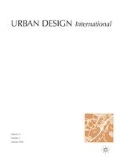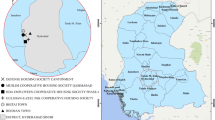Abstract
Urban Planners have stressed the important role of street physical attributes for enhancing livability and activity in the area. The purpose of this study is to identify physical attributes of streetscapes that influence street livability. Previous studies focused mainly on traffic management as a major determinant of street livability. Studies that address people’s perception of street physical attributes as influencing street livability tend to separate. This study is an empirical examination of people’s perception of the physical attributes of Kuala Lumpur streetscapes. Structured observations and a questionnaire survey were used to identify determinants of street livability in two multi-functional streets located in the inner part of Kuala Lumpur. On the basis of literature review and observation of the studied areas, 14 physical attributes of street were identified and evaluated. Findings show that provision of facilities like paving, maintenance, parking space and traffic calming techniques contribute to street livability in Kuala Lumpur streetscapes. Indeed, the result of this study is recommended to Malaysian practitioners and policymakers. This result indicates the most significant factors that need to pay attention to meet human needs in designing livable spaces in Kuala Lumpur City Center.























Similar content being viewed by others
References
Appleyard, D. (1981) Livable Streets. Berkeley, CA: University of California Press.
Appleyard, D. and Lintell, M. (1972) The environmental quality of city streets: The residents’ viewpoint. Journal of the American Institute of Planners 38 (2): 84–101.
Bentley, I., Alcock, A., Murrain, P., McGlynn, S. and Smith, G. (1985) Responsive Environments: A Manual for Designer. Oxford: Architectural Press.
Biddulph, M. (2012) Radical streets? The impact of innovative street designs on liveability and activity in residential areas. Urban Design International 17 (3): 178–205.
Bosselmann, P., Macdonald, E. and Kronemeyer, T. (1999) Livable streets revisited. Journal of the American Planning Association 65 (2): 168–180.
Carr, S., Francis, M., Rivlin, L. and Stone, A. (1992) Public Space. Cambridge: Cambridge University Press.
Cherulnik, P. D. (1993) Applications of Environment-behavior Research. New York, NY: Cambridge University Press.
Coakes, S.J. and Steed, L. (2007) SPSS: Analysis Without Anguish: Version 14.0 for Windows. Australia: John Wiley & Sons Australia.
Creswell, J.W. (2009) Research Design: Qualitative, Quantitative, and Mixed Methods Approaches. United States of America: SAGE Publication.
Davis, M. (1990) City of Quartz: Excavating the Future in Los Angeles. London.
De Vaus, D.A. (2002) Surveys in Social Science. London: Routledge.
Dooley, D. (2001) Social Research Methods. Prentice Hall.
Duany, A., Plater-Zyberk, E. and Speck, J. (2000) Suburban Nation: The Rise of Sprawl and the Decline of the American Dream. New York: North Point Press.
Dumbaugh, E. and Gattis, J. (2005) Safe streets, livable streets. Journal of the American Planning Association 71 (3): 283–300.
Forsyth, A., Hearst, M., Oakes, J.M. and Schmitz, K.H. (2008) Design and destinations: Factors influencing walking and total physical activity. Urban Studies 45 (9): 1973–1996.
Francis, M. (1991) The making of democratic streets. In: A.V. Moudon (ed.) Public Streets for Public Use. New York: Columbia University Press.
Gehl, J. (1987) Life Between Buildings: Using Public Space. New York, NY: Van Nostrand Reinhold.
Gehl, J. (2001) Life Between Buildings: Using Public Space. Copenhagen, Denmark: Danish Architectural Press.
Gjerde, M. (2011) Visual evaluation of urban streetscapes: How do public preferences reconcile with those held by experts? Urban Design International 16 (3): 153–161.
Hedman, R. and Jaszewski, A. (1984) Fundamentals of Urban Design. Washington DC: APA Planners Press.
Jacobs, A. and Appleyard, D. (1987) Toward an urban design manifesto. Journal of the American Planning Association 53 (1): 112–120.
Jacobs, J. (1961) The Death and Life of Great American Cities. New York: Random House Digital, Inc.
Kum, T.L. and Ujang, N. (2012) The application of mental mapping technique in identifying the legible elements within historical district of Kuala Lumpur city centre. ALAM CIPTA Journal 5 (1): 55–62.
Layne, M.R. (2009) Supporting intergenerational interaction: Affordance of urban public space. PhD Thesis, Graduate Faculty of North Carolina State University.
Lo, S. M., Yiu, C. Y. and Lo, A. (2003) An analysis of attributes affecting urban open space design and their environmental implications. Management of Environmental Quality: An International Journal 14 (5): 604–614.
Lynch, K. (1981) A Theory of Good City Form. Cambridge: MIT Press.
Mackett, R.L., Achuthan, K. and Titheridge, H. (2008) AMELIA: Making streets more accessible for people with mobility difficulties. Urban Design International 13 (2): 80–89.
Madanipour, A., Cars, G. and Allen, J. (1998) Social Exclusion in European Cities: Processes, Experiences, and Responses. London: Jessica Kingsley.
Marcus, C.C. and Francis, C. (eds.) (1998) People Places: Design Guideline for Urban Open Spaces. New York: John Wiley & Sons.
Mehta, V. (2007) Lively streets: Determining environmental characteristics to support social behavior. Journal of planning education and research 27 (2): 165–187.
Nasar, J.L. (1998) The Evaluative Image of the City. Thousand Oaks, CA: Sage Publications.
Park, S. (2008) Defining, measuring, and evaluating path walkability, and testing its impacts on transit users’ mode choice and walking distance to the station. PhD Thesis, University of California.
Portella, A.A. (2007) Evaluating commercial signs in historic streetscapes: The effects of the control of advertising and signage on user’s sense of environmental quality. PhD Thesis, Oxford Brookes University.
Pushkarev, B. and Zupan, J. (1975) Urban Space for Pedestrians. Cambridge: MIT Press.
Rapoport, A. (1982) The Meaning of the Built Environment: A Nonverbal Communication Approach. Beverly Hill, CA: Sage Publications.
Rehan, R.M. (2013) Sustainable streetscape as an effective tool in sustainable urban design. Housing and Building National Research Center Journal 9 (2): 173–186.
Rubenstein, H.M. (1992) Pedestrian Malls, Streetscapes, and Urban Spaces. New York: John Wiley & Sons.
Sanoff, H. (1991) Visual Research Methods in Design. New York: Van Nostrand Reinhold.
Sauter, D. and Huettenmoser, M. (2008) Liveable streets and social inclusion. Urban Design International 13 (2): 67–79.
Shaftoe, H. (2008) Convivial urban spaces: Creating effective public places. Retrieved from http://site.ebrary.com/lib/malaya/docPrint.action?.
Shamsuddin, S. and Ujang, N. (2008) Making places: The role of attachment in creating the sense of place for traditional streets in Malaysia. Habitat International 32 (3): 399–409.
Soja, E. (1989) Postmodern Geographies: Reassertion of Space in Critical Social Theory. London: Verso.
Tomalin, C. (1998) Urban spaces in town centres: a route to success. Built-Environment 24 (1): 35–36.
Wagner, F. and Caves, R. (2012) Community Livability: Issues and Approaches to Sustaining the Well-Being of People and Communities. london: Routledge.
Whyte, W.H. (1988) City: Rediscovering the Center. New York: Bantam Doubleday Dell Publishing Group.
WMO World Weather Forecast. (2012) Weather information for Kuala Lumpur, http://www.worldweather.org/020/c00082.htm, accessed 20 March 2012.
Yin, R.K. (2003) Case Study Research Design and Methods. London: Sage publication.
Author information
Authors and Affiliations
Corresponding author
Rights and permissions
About this article
Cite this article
Mahmoudi, M., Ahmad, F. Determinants of livable streets in Malaysia: A study of physical attributes of two streets in Kuala Lumpur. Urban Des Int 20, 158–174 (2015). https://doi.org/10.1057/udi.2015.3
Published:
Issue Date:
DOI: https://doi.org/10.1057/udi.2015.3




